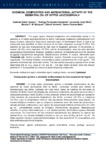Use este identificador para citar ou linkar para este item:
http://www.alice.cnptia.embrapa.br/alice/handle/doc/1039641| Título: | Chemical composition and antibacterial activity of the essential oil of Hyptis leucocephala. |
| Autoria: | SANTOS, S. N.  CASTANHA, R. F.   SILVA, L. J.   MARQUES, M. O. M.   SCRAMIN, S.   MELO, I. S. de   |
| Afiliação: | SUIKINAI NOBRE SANTOS; RODRIGO FERNANDES CASTANHA, CNPMA; LEONARDO JOSE SILVA; MARCIA ORTIZ MAYO MARQUES, IAC; SHIRLEI SCRAMIN; ITAMAR SOARES DE MELO, CNPMA. |
| Ano de publicação: | 2015 |
| Referência: | Atas de Saúde Ambiental, São Paulo, v. 3, n. 1, 9 p. 3-11, 2015. |
| Conteúdo: | Abstract: The paper reports chemical composition and antimicrobial activity of the essential oil of Hyptis leucocephala Mart ex Benth, Lamiaceae, isolated by hydrodistillation from leaves of plants collected in Casa Nova, semi-arid region of Northeastern Brazil. A total of ten compounds were identified, of which carvacrol as the main component (average 52.82%). This essential oil was also characterized by high level of biogenetic precursor of the phenols: p-cimene (18.13%) and y-terpinene (10.72%), and by E-cariophyllene, were the most abundant sesquiterpene hydrocarbons. Bioassay revealed a significant antibacterial activity of the essential oil against Pseudomonas aeruginosa, Staphylococcus schleiferi, S. aureus, Salmonella typhi, E. coli, Bacillus pumillus, Burkholderia cepacia, Klebsiella pneumoniae with varying magnitudes. The minimal inhibition concentrations values extended from 50 to 250 µg mL-1. The essential oil showed high antioxidant activity. The free radical scavenging capacity of the oil was determined with an EC50 value of 3.41 mg mL-1. The data herein obtained show the relevant potential of H. leucocephala as a source of potent bioactivity compounds. Resumo: O artigo relata composição química e atividade antimicrobiana do óleo essencial de Hyptis leucocephala Mart ex Benth, Lamiaceae, extraído pelo método de hidrodestilação das folhas, coletadas em Casa Nova, região de Caatinga do semi-árida do Nordeste do Brasil. Foram identificados dez compostos majoritários, dos quais carvacrol como o componente principal (média 52,82%). O óleo essencial também foi caracterizado por apresentar níveis elevados de precursores biogenéticos dos fenóis: p-cimeno (18,13%) e y-terpineno (10,72%), e por E-cariophyllene, como os mais abundantes hidrocarbonetos sesquiterpeno. Os ensaios biológicos revelaram que os compostos presentes neste óleo essencial apresentaram elevada atividade antibacteriana com valores da concentração inibitória mínima entre 50 a 250 μg mL -1 , principalmente contras as linhagens Pseudomonas aeruginosa, Staphylococcus schleiferi, S. aureus, Salmonella typhi, E. coli, Bacillus pumillus, Burkholderia cepacia, Klebsiella pneumoniae. Os constituintes do óleo essencial apresentaram alta eficiência na captura dos radicais livres, com elevada atividade antioxidante, com um valor de EC 50 de 3,41 mg mL -1 . Os dados expostos reforçam o potencial biotecnológico do óleo essencial de H. Leucocephala, uma fonte alternativa para novos bioativos. |
| Thesagro: | Óleo essencial Caatinga |
| NAL Thesaurus: | Lamiaceae Essential oils Antibacterial plants Antioxidant activity Semiarid zones carvacrol |
| Palavras-chave: | Agente antibacteriano Agente antioxidante Bioma caatinga Antibacterial agent Antioxidant agent |
| Tipo do material: | Artigo de periódico |
| Acesso: | openAccess |
| Aparece nas coleções: | Artigo em periódico indexado (CNPMA)  |
Arquivos associados a este item:
| Arquivo | Descrição | Tamanho | Formato | |
|---|---|---|---|---|
| 2015AP046.pdf | 321,73 kB | Adobe PDF |  Visualizar/Abrir |









